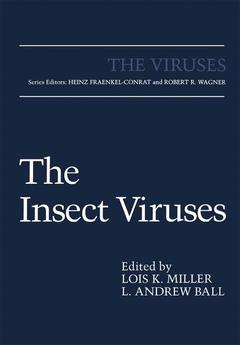The Insect Viruses, Softcover reprint of the original 1st ed. 1998 The Viruses Series
Langue : Anglais
Coordonnateurs : Miller Lois K., Ball L. Andrew

There are over a million different species of insects, and individually they 8 outnumber humans by more than 10 to 1. Moreover, some insects live in close association with both plants and higher animals and naturally exchange viruses with them. It has even been speculated that viruses in general may have radiated through the plant and animal kingdoms from common insect origins. Be that as it may, since insects play pivotal roles in the biosphere, both to the benefit and detriment of mankind, they and the viruses that infect them are important subjects for study. Insects are infected by a diverse medley of viruses, and this volume focuses on those insect virus families that are found primarily or exclusively in insects. All major families of insect-selective viruses are covered except for the baculo viruses, which were described in a separate volume of The Viruses series. Included in this volume are the established families of insect viruses, the newly recognized ascovirus family, and the nudiviruses, which probably represent a separate family but currently remain unclassified. The coverage of arboviruses is limited to a single chapter that focuses on their potential utility as vectors and in insect control. Omitted for practical reasons are several individual insect viruses that have been described sporadically in the literature and probably represent novel virus families.
1 Entomopoxviruses.- I. Introduction.- II. Classification.- III. Virus Structure.- IV. Virus Replication.- V. Entomopoxvirus Genome Structure.- VI. Biological Control.- References.- 2 Invertebrate Iridescent Viruses.- I. Introduction.- II. Classification.- III. Structure and Composition.- IV. Replication and Molecular Biology.- V. Signs and Characteristics of Patent Disease.- VI. Relationships among IVs.- VII. Ecology.- VIII. Use of Iridescent Viruses in Biocontrol.- References.- 3 Nudiviruses.- I. Introduction.- II. Oryctes Virus.- III. Hz-1 Virus.- IV. Gonad-Specific Virus.- V. Other Nudiviruses.- References.- 4 Ascoviruses.- I. Introduction.- II. Structure and Classification.- III. Cytopathology and Assembly.- IV. Histopathology and Disease Presentation.- V. Transmission and Occurrence.- VI. Summary.- References.- 5 Polydnavirus Biology, Genome Structure, and Evolution.- I. Introduction.- II. Polydnavirus and Parasitoid Classification.- III. Polydnavirus Morphology and Genomes.- IV. Polydnavirus Genome Organization.- V. Polydnavirus Replication.- VI. Polydnavirus Gene Expression.- VII. Polydnavirus Evolution.- VIII. Future Directions.- References.- 6 Biological and Molecular Properties of Densoviruses and Their Use in Protein Expression and Biological Control.- I. Introduction.- II. Pathologies Associated with Densoviruses.- III. Host Range.- IV. Replication of Densoviruses in Insect Cell Cultures.- V. Composition and Structure of Densoviruses.- VI. Molecular Biology of Densoviruses.- VII. Development of DNV-Derived Expression Vectors.- VIII. Use of DNVs for Biological Control of Insect Pests.- References.- 7 Structural Studies of Nodaviruses and Tetraviruses.- I. Introduction.- II. Nodavirus Particle.- III. Particle Maturation.- IV. Protein—RNA InteractionsDerived from Cryo-Electron Microscopy and X-Ray Analysis.- V. Viral Entry and RNA Delivery.- VI. Tetravirus Structure and Function.- VII. Conclusions.- References.- 8 Nodaviruses of Insects.- I. Introduction.- II. Classification and Taxonomy.- III. Isolation, Ecology, and Natural Infections.- IV. Host Cell Interactions and Cytopathology.- V. Virion Composition, Properties, and Structure.- VI. Genome Organization and Molecular Biology.- VII. Virus Replication Cycle.- VIII. Viral Genetics.- IX. Experimental RNA Replication Systems.- X. Technological Applications of the Nodaviridae.- XI. Conclusions and Summary.- References.- 9 Tetraviruses.- I. Introduction and History.- II. Taxonomy, Serology, and Host Range.- III. Purification.- IV. Virion Properties and Structure.- V. Genome Organization and Molecular Biology.- VI. Pathobiology.- VII. Epidemiology and Ecology.- VIII. Tetraviruses and Biotechnology.- IX. Concluding Remarks.- References.- 10 Picornalike Viruses of Insects.- I. Introduction.- II. The Picornalike Viruses.- III. The Cricket Paralysis Virus-Drosophila C Virus Complex.- IV. The Picornalike Viruses of Domesticated Bees.- V. The Picornalike Viruses of Dipterans.- VI. The Picornalike Viruses of Hemipterans.- VII. The Picornalike Viruses of Lepidopterans.- VIII. Summary.- References.- 11 Cypoviruses.- I. Introduction.- II. Biochemical Characteristics of the Cypoviruses.- III. Classification and Strain Characteristics.- IV. Viral Replication Cycle.- V. Effects of the Virus Infection.- VI. Interactions of CPV with Insect Pathogens: Synergisms and Antagonisms.- VII. Use of Cypoviruses in Biological Control Programs of Insect Pests.- VIII. Conclusion.- References.- 12 Sindbis Virus Expression Systems for the Manipulation of Insect Vectors.- I. Introduction.- II. Virus Expression Systems.- III. Virogenesis of Alphaviruses in Vectors.- IV. Alphavirus Expression Systems.- V. Sindbis Virus Expression Systems.- VI. Expression of Heterologous Proteins from SIN Virus Transducing System.- VII. Knockout of Bunyaviruses in Mosquitoes Using SIN Expression Systems.- VIII. Knockout of DEN-2 Virus in Mosquitoes Using SIN Expression Systems.- IX. Summary.- References.
Microbiologists , entomologists , molecular biologists.
Date de parution : 10-2012
Ouvrage de 416 p.
17x24.4 cm
Thèmes de The Insect Viruses :
Mots-clés :
RNA; biological; biology; classification; development; ecology; epidemiology; evolution; genetics; illustration; insects; morphology; system; taxonomy; virus
© 2024 LAVOISIER S.A.S.



